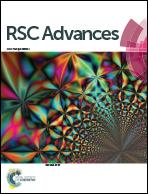Enhanced xenon adsorption and separation with an anionic indium–organic framework by ion exchange with Co2+†
Abstract
The separation of xenon/krypton is industrially significant and an environmental concern. Adsorptive capture and separation xenon from krypton using porous MOFs provides an energy and capital efficient approach compared with the current cryogenic distillation process. Herein, we investigated the adsorptive Xe/Kr separation potential of three anion In-MOFs (CPM-5, CPM-6 and the Co2+-exchanged framework analogue Co2+-CPM-6). Anionic In-MOF Co2+-CPM-6 with Co2+ ions in pore spaces has been obtained using a simple cation-exchange process and exhibits much higher Xe adsorption capacity and Xe/Kr selectivity than organic cation-analogues CPM-5 ([(CH3)2NH2]+) and CPM-6 ([CH3NH3]+), verified by single-component gas isotherms, IAST calculations and breakthrough experiments. The enhanced adsorptive Xe/Kr separation performance for Co2+-CPM-6 could be due to the increased pore size or accessible micropore volume and enhanced electric field within the pore spaces, which could induce strong interaction with Xe and simultaneously reduce the affinity with Kr.



 Please wait while we load your content...
Please wait while we load your content...